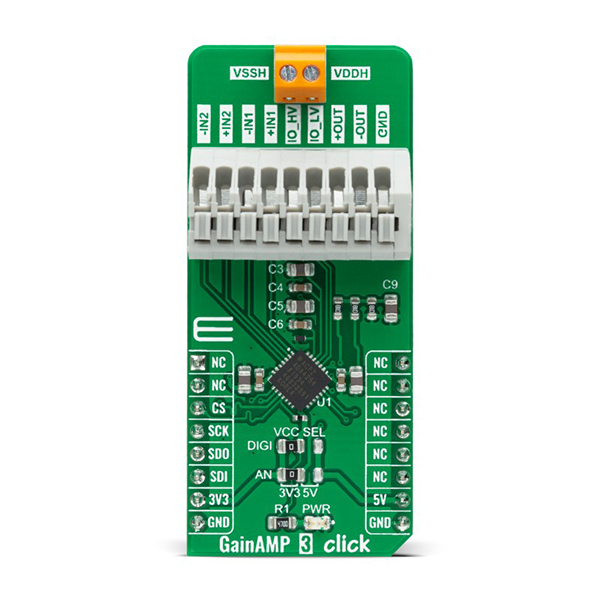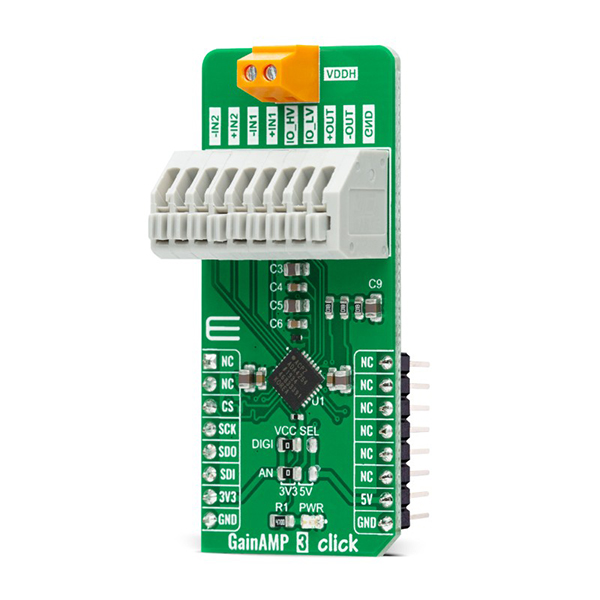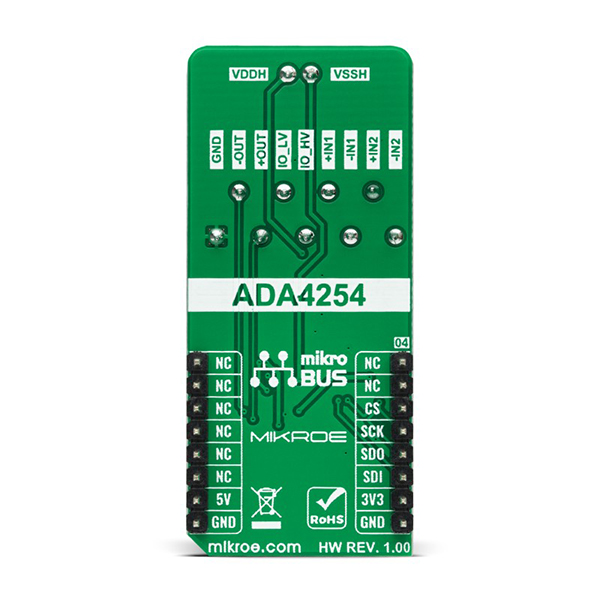MIKROE GainAMP 3 Click is a compact add-on board that contains a 4-channel programmable gain amplifier. This board features the ADA4254, a zero drift, high voltage, programmable gain instrumentation amplifier from Analog Devices. It features 12 binary weighted gains and three scaling gain options resulting in 36 possible gain settings. It comes with an input multiplexer providing ±60V protection to the high impedance inputs of the amplifier and an excitation current source output available to bias sensors such as resistance temperature detectors (RTDs). The ADA4254 zero-drift amplifier topology self-calibrates DC errors and low-frequency noise, achieving excellent DC precision over the entire specified temperature range, maximizing dynamic range, and significantly reducing calibration requirements in many applications. This Click board™ represents a perfect choice for industrial systems and process control that demand precision, robustness, and low power, thanks to its low power consumption.
GainAMP 3 Click is supported by a mikroSDK compliant library, which includes functions that simplify software development.
GainAMP 3 Click as its foundation uses the ADA4254, a zero drift, high voltage, programmable gain instrumentation amplifier (PGIA) designed for process control and industrial applications from Analog Devices. It accurately measures sensors, voltages, and currents with wide dynamic ranges and provides safety information about what is being measured. It features 12 binary weighted gains ranging from 1/16V/V to 128V/V and three scaling gain options of 1V/V, 1.25V/V, and 1.375V/V, resulting in 36 possible gain settings. Its zero-drift amplifier topology self-calibrates DC errors and low-frequency noise, achieving excellent DC precision over the entire specified temperature range, maximizing dynamic range, and significantly reducing calibration requirements in many applications.
The ADA4254 communicates with MCU using the standard SPI serial interface with a maximum frequency of 5MHz, supporting the most common SPI mode, SPI Mode 0. It comes with a 4-channel input multiplexer providing ±60V protection to the high impedance inputs of the amplifier and an excitation current source output available to bias sensors such as resistance temperature detectors (RTDs). In addition to these channels located on the onboard 9-pole connector, the ADA4254 also has a differential output stage and output excitation current channels.
A differential output stage allows the device to be directly connected to high-precision ADCs. When making such a connection, it is recommended to use a low-pass filter before a connection to the ADCs to minimize noise and aliasing. A software configurable excitation current outputs can be used to excite external circuitry, such as resistive bridges or RTD sensors, and be programmed to a value from 100μA to 1.5mA in increments of 100μA.
This Click board™ can operate with both 3.3V and 5V logic voltage levels selected via the VCC SEL jumper. In addition to choosing the logic voltage level using jumper labeled as DIGI, it is also possible to select the supply voltage of the amplifier using the AN jumper by positioning SMD jumpers to an appropriate position. This way, it is allowed for both 3.3V and 5V capable MCUs to use the SPI communication lines properly. However, the Click board™ comes equipped with a library containing easy-to-use functions and an example code that can be used, as a reference, for further development.
- Interface: SPI
- Compatibility: mikroBUS™
- Dimensions: 57.15 x 25.4mm
- Input Voltage: 3.3V or 5V, External
- Supply Voltage VCC: Min. 3.3V, Max. 5V
- External Supply Voltage VDDH − VSSH: Min. 10(±5)V, Max. 56(±28)V
- Gain Steps: Min. 1/16 V/V, Max. 128 V/V
- Operating Temperature Range: Min. -40°C, Typ. +25°C, Max. +125°C
MIKROE GainAMP 3 Click Product Help and Resources
Comments
Looking for answers to technical questions?
We welcome your comments and suggestions below. However, if you are looking for solutions to technical questions please see our Technical Assistance page.
Customer Reviews
No reviews yet.



